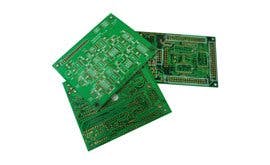Single and Multi-Layer PCBs: Know the Difference
Before you design a printed circuit board you will have to decide whether you are going to use a single layer or a multi-layer PCB. Both of these designs are very common and can be found in a wide variety of devices that we use every day. The type of PCB that’s right for you will depend on how you plan to use it. Many complex devices tend to use multi-layer PCB and the simpler devices use single layer PCB’s.
What is the Difference Between Them?
**
Single Layer PCB’s**
Single layer printed circuit boards have their components on just one side of the board. The conducting pattern is located on the other side of the board. There is typically one single layer of conductive material which is likely to be copper. A single layer PCB is made up of a substrate layer, a conductive metal (Copper) layer, and a final layer. This final layer is a protective solder mask and a silk screen.
Multi-layer PCB’s

PCB’s such as these usually have at least 3 double sided boards that are stacked on top of each other. Multi-layer boards can contain as many boards as you need. However, they tend to have between 4 and 12 layers. Odd numbers of layers can cause twisting and warping.
Every substrate latter has a conductive metal that’s located on both sides. A special adhesive is used on each board to join them together. Vias (paths) let the layers conduct each other. The vias fall into 3 different groups:
Blind – which connect and outer layer of PCB to an inner layer
Buried – which connect 2 inner layers and ensure they are invisible from outside the board
Through-hole – which goes through every single layer of the PCB
The Pros and Cons of Each Circuit Board
When we look at a single vs multilayer pcb we see that each of the pros and cons, these are:
Single Pros
They have a lower cost
A simpler design
Can be produced at a higher volume
Shortened lead time
Single Cons
They can be too simple for complex projects
Has a lower operating capacity
Has a slower speed
Weighs more
Is larger in size
Multi-layer Pros
Ideal for complicated projects
Is usually very high-quality
Has increased power
Has more durability
Weighs less than a single PCB
Is smaller in size
Has one connection point
Multi-layer Cons
Costs more than a PCB
Is less available
Has longer lead times
Complex repairs may be needed
Determining What Type of PCB you Need
When deciding which type of PCB you need you will have to consider the level of functionality that’s needed and the maximum size of the board. You will also need to consider whether you need a durable PCB along with your budget. Finally, you will need to look at how soon you need the PCBs.
When you take all of these factors into consideration you’ll have a better idea of what type of Printed Circuit Board you need.